Determining whether a tree is dead can be more challenging than it seems, especially during winter when dormant trees might appear lifeless but come back to life in full bloom in the spring. Trees typically don’t die suddenly; for instance, an oak tree may take up to 300 years to reach the end of its life cycle. If you’re concerned about the health of a tree, there’s usually ample time to seek advice from a certified tree surgeon. An experienced professional can help alleviate stress on a struggling tree through pruning or dead wooding, potentially restoring its vitality.
What is Dead Wooding?
Dead wooding involves the removal of dead branches and limbs from a living tree, similar to how deadheading removes spent flowers from plants. This practice helps maintain the tree’s health and minimises the risk of large branches falling unexpectedly, which could be hazardous. Dead wooding should be performed by a qualified tree surgeon, such as those at Ross Giles.
Signs Your Tree May Be in Trouble
Lack of Vitality
One of the first indicators of a tree in distress is a lack of growth, evidenced by few or no leaves and buds. A significant number of fallen twigs and branches beneath the tree can also signal trouble. While deciduous trees don’t lose their leaves or needles all at once, they should look vibrant and green in the spring. Browning needles are usually a bad sign.
Is the Tree Tilting?
If the tree leans, it could mean the roots have been compromised by erosion, nearby excavation, or compacted soil loosened by heavy rain. In such cases, the roots might not be strong or deep enough to keep the tree stable. Epicormic shoots at the base of the trunk can also indicate that the tree is under severe stress.
Is Fungus an Issue?
Fungi like mushrooms or toadstools growing on or near the tree can indicate decay. While some fungi, such as chicken of the woods, can grow on both dead and living trees and may not be a significant concern, others can be problematic. Fungus thrives on decaying organic matter and can spread to the roots, trunk, and branches.
Cracking and Peeling Bark
Cracks or peeling bark can expose a tree to disease. Ash dieback, a destructive fungal disease, has led to the widespread loss of ash trees throughout Europe. If you have an ash tree, it may already be dying, and professional intervention may be necessary to remove it safely.
Checking Your Tree’s Health
Beyond a visual inspection—such as assessing leaf health or looking for fungus—there are more definitive methods to evaluate a tree’s condition. Try snapping a twig; if it easily breaks, the branch is likely dead, though this doesn’t necessarily mean the whole tree is. A flexible twig that bends and returns to its position is usually a sign of a healthy, moist branch. Another method is to remove a small piece of bark to check the cambium layer underneath. A green and moist cambium layer indicates the tree is still functioning, while a dry, brown layer suggests the tree may be dead or dying. This technique should be done carefully, preferably by a professional, to minimise damage to the tree.
Should a Dead Tree Be Removed?
While a dead tree can be unsightly and potentially dangerous—posing risks to nearby structures and people if it falls—there are circumstances where it can be left standing. For example, a dead tree can provide essential habitats for wildlife, such as nesting and breeding sites for birds and beneficial insects. However, if the tree is diseased, especially with something as destructive as emerald ash borer, it’s crucial to remove it to prevent the disease from spreading. In such cases, professional tree felling and removal are necessary.
Ross Giles Tree Surgery Inspection Service
At Ross Giles Tree Surgery, our experienced and qualified tree surgeons will carefully assess your tree’s condition and discuss your options, recommending the most appropriate course of action. In urban areas like London, every tree is a valuable asset with sentimental, environmental, and aesthetic significance, and we are committed to preserving trees whenever possible.
If you need expert tree care services in South West London, whether for a single tree or multiple trees, please contact us for a free quote. We’d be happy to assist with all your tree care needs!




